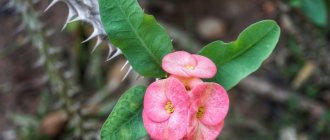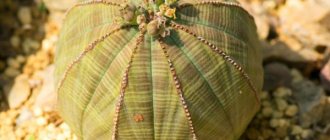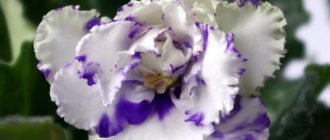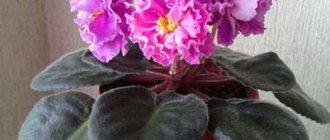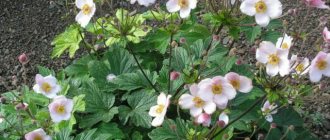What does violet Raisin look like?
The Raisin variety belongs to the Violet genus and the Violet family. There are more than 600 species of this plant in the world, but even against their background, Raisin can surprise.
Violet Raisin with variegated flowers
Violet Raisin or DS-Raisin has a very memorable appearance due to its unusual inflorescences.
The compact bush has a height of 30-40 centimeters. The leaf blades grow directly from the basal rosette and have a teardrop shape. Their surface is smooth, and the color is solid dark green without inclusions or light areas or veins.
Violet DS Raisin was developed by crossing varieties found at the end of the 19th century by a British baron who traveled to East Africa. Breeders made many different hybrids of these flowers in the mid-20th century, the most beautiful of which was the DS Raisin violet.
This is interesting! Among some plant lovers there is an opinion that in Latin violet is written as “violet”. In fact, this is not so - in the West they are called Saintpaulia (Latin: Saintpaulia).
What is sport among fantasy saintpaulias?
You can often hear the term “violet sport”, what does this mean? There is nothing complicated in this word; this is how they designate varieties that, over a long period of cultivation, have managed to lose the properties and characteristics of their ancestor variety. As a rule, such flowers can already be called a new subspecies of violets.
- Leaf sport
Leaf blades may undergo noticeable changes in shape and color. This is influenced by the conditions under which the bush is kept, the method of its propagation, the quality of fertilizing and the pH level of the soil.
- Sport of flowers
Violet sport suffers noticeable changes in the characteristics of its flowers. Due to genetic mutations and the effects of certain external factors, the color and shape of the inflorescences can completely change. Raisin's ancestors had a solid lilac color, and the current plant has left this external resemblance to a small extent.
Types of garden violets and their features
Violet is a fairly common plant that grows in European and central Eurasia. Some species are also found in North America. It has been known since the times of the Roman Empire, which is where its main name Viola came from. At that time, only perennial wild-growing species were found, such as fragrant violet, butterfly violet, etc.
What does a garden violet look like?
For your information! From the 16th century Viola began to be cultivated, developing new decorative varieties. So, by the end of the 19th century. a beauty appeared called Vittroka, better known in Russia as pansy. Other decorative varieties of violets were also created, today numbering more than 400 species.
Perennial fragrant garden violet
This is perhaps the most unpretentious species of the Viola family. It often happens that this flower starts on its own in the area, since this wild plant actively reproduces by seeds. It also takes root easily with the help of a creeping stem. But there is no need to worry about her acting like a weed. Usually it settles in one clearing and pleases with its abundant flowering from the last days of March to the end of May.
Note! Flowering can last longer if faded boxes are removed in a timely manner. Garden violet grows in small bushes with a very branched root.
The leaves are simple, solitary, heart-shaped. The peduncles do not branch, but have one flower on each. This species is short, up to 10-12 cm tall. The flowers are also quite small, 1-1.5 cm in diameter
Garden violet grows in small bushes with very branched roots. The leaves are simple, solitary, heart-shaped. The peduncles do not branch, but have one flower on each. This species is short, up to 10-12 cm tall. The flowers are also quite small, 1-1.5 cm in diameter.
The color of wild species is predominantly purple: from light lilac, closer to blue, to dark. Decorative varieties may have terry petals of a bright shade.
The fragrant violet is very fragrant, as its name suggests. This is also why many people love her.
In nature it grows in meadows and clearings, in sparse deciduous forests. In the garden it prefers a sunny place with partial shade. In Russia it lives in the central zone.
Violet white moth
Looking at these flowers, at first glance it may seem that a flock of white moths has perched on the clearing. Hence the name. This species is very reminiscent of fragrant violet, but its flowers and leaves are larger. The height of the plant reaches 20 cm, and the diameter of the flowers is 2.5 cm.
In the wild, the butterfly violet is common in North America, but also thrives in Russian latitudes.
For your information! Under snow it can survive winters down to −20 °C, since the white garden violet is a perennial.
There are decorative varieties of this species, for example, Freckles. This is a viola with larger flowers of bright colors. It is best known as sister violet. It is distinguished by its light petals with purple specks. There are other colors: blue, purple, yellow.
The flowering time of the perennial white butterfly violet coincides with the fragrant one. Sometimes it blooms again at the end of summer. Prefers partial shade.
Horned violet
This type is more decorative. The flowers are much larger than those of a simple violet, with a diameter of 3 to 5 cm. Depending on the variety, the total height is 10-30 cm.
Note! The species got its name due to the presence of a lower sepal at the back of the flower, reminiscent of horns. Some hybrids don't have it
Just like the previous violas, it bushes well thanks to creeping stems and roots, forming bright flowering meadows.
This species is distinguished by its very bright and varied colors from the lightest tones to dark purple. Petals can be either single-color with a yellow or white core, or two- or three-color.
Viola hornata is a perennial. Unlike simple varieties, it blooms for a longer time: from April to October. In hot, dry summers, flowering may be suspended in July-August.
Wittrock violet
Vittroka is the most diverse flower in terms of colors and decorativeness, popularly known as pansy. This species is not found in the wild, as it was completely bred by breeders. Compared to its ancestor, the fragrant violet, the diameter of Vittroki's flowers is 10 times greater, and the variety of colors is amazing.
Pansies are annuals or biennials. Flowering continues from April to October, but may take a break in mid-summer and resume by autumn. It will bloom continuously in cool, rainy summers.
Features of caring for violet DS Raisin at home
Violet Fairy - description and characteristics of the variety
Violets cannot be called unpretentious flowers, as there are several nuances in their care that need to be paid special attention to.
- Temperature
The most comfortable temperature for the heat-loving violet is +23 degrees. A decrease or strong changes in its maintenance regime will lead to negative consequences for the plant.
- Lighting
The bush should be grown in an open place, but direct sunlight often burns the leaf blades of the flower, so the pot should be placed not on the southern sides of the house, but on the western or eastern side.
The plant needs to be watered regularly
- Watering
The soil in the pot should always be moist, but loose. It is recommended to water the plant 2-3 times a week, and mulching can be done to retain moisture.
Important! After watering, it is recommended to loosen the soil 2-3 centimeters deep.
- Spraying
Spraying is very necessary for Zest, especially during dry periods. In addition, this procedure removes dust and dirt from the leaf plates of the bush.
- Humidity
Air humidity is of great importance for the normal growth of the bush. The most optimal indicator is 50%.
To increase humidity, water is sprayed near the violet bush, and the leaf blades are carefully wiped with a damp cloth.
- Priming
The soil in the pot should be loose and light. To ensure that the flower does not lag behind in development, fertilizers must be regularly added to the soil.
- Feeding
For feeding, it is better to choose ready-made complex mineral preparations. They should contain high levels of phosphorus and potassium.
Fertilizing violets should be carried out only in spring and summer; in autumn and winter they are contraindicated due to the excess load on the bush.
Peculiarities of propagation of perennial garden violet
Viola can be propagated not only using seeds. It also spreads well vegetatively. There are several ways to do this.
- the simplest one is rooting cuttings. A long shoot is leaned against the ground and the area is sprinkled with it. Water regularly for 3-4 weeks. When the shoot produces its own roots, it is separated from the mother plant;
- by dividing the bush. To do this, dig up a large violet bush and carefully divide it into 2 or 3 parts. The separated plants are planted in a prepared and well-moistened place. During the rooting period, the viola needs to be shaded for 2-3 weeks;
- cuttings To do this, cut stems 5 cm high from the bush, leaving 2-3 leaves on top. The lower part is stuck into prepared containers with moistened soil to a depth of 1-2 cm. The containers are covered with film and left in a bright place, but protected from direct sunlight. Within a month, the cuttings should sprout new roots and leaves.
When and how does it bloom
Violet Magenta - description and characteristics of the variety
The blossoming of Raisins is a beautiful and memorable event thanks to the colors of the small buds.
The flowers have one type of color and shape for the entire variety. They are painted in a delicate purple hue and have small white specks on each petal. But some of them only have these dots on the edges.
Violet blossom Raisin
One rosette can contain from 5 to 10 flowers, which consist of one large wavy petal. Short yellow stamens are clearly visible in the middle.
For reference! Violet has two noticeable waves of flowering. The first begins in early April and continues until May, the second will follow immediately - from May to June.
Changes in care during the flowering period
During flowering, the frequency of fertilizing begins to be reduced, and nitrogen-containing preparations are stopped altogether.
Also during this period, the bush should be slightly moved away from the window so that the bright sun does not harm the buds.
Bush formation
Violet, unlike some other plants, does not require systematic removal of petals.
However, to maintain a certain shape, it is necessary to maintain uniform proportions: the bush must consist of three uniform rows of leaves.
You can also remove the lower leaves and be sure to remove dry and damaged ones. During removal, you should carefully grasp the stem with your fingers and cut it off with scissors.
Violet “Raisin” is suitable even for those people who do not have a lot of time for household chores. This variety is very unpretentious and easy to care for. Violet can harmoniously complement any interior and “revive” it.
If the violet that you grew from a leaf often gets sick and does not bloom, we advise you to read the materials at the links.
How Saintpaulia DS Raisin propagates
Picture 4 Planting a seedling in the ground
Violet SM Amadeus pink - description and characteristics of the variety
Saintpaulia is propagated by rooting leaves. The description of the procedure is as follows:
- cut off a leaf from an adult plant at the root;
- put its end into the water;
- When the leaf has roots, you need to transplant it into a container with substrate.
Attention! It is best to cut medium-sized leaves, not the oldest ones, but not the youngest ones either.
Reproduction methods
Would you like such a violet in your collection?
Of course not
In order to get a new plant,
you need to carefully cut a leaf from an old bush and put it in water .
You need to wait until the leaf gives roots, after which you need to carefully transplant the leaf into a small pot, without damaging its root system, and wait until it produces “babies.”
These are new small rosettes that need to be planted either in one container at some distance from each other, or in separate small pots.
As Saintpaulias grow, they need to be replanted into slightly larger pots. The “baby” usually grows to the size of an adult plant in 2-3 months. Most likely in another month it will begin to bloom.
The first flowering is usually very modest - don’t be upset . Later, the plant will grow and become stronger, then the flowers will be different.
Read about other methods of propagating Saintpaulia in a separate article.
Transplantation after purchase and during reproduction
To replant, you need a high-quality and nutritious soil mixture, which you can purchase in specialized stores or make yourself. You need to take loose turf soil and mix it with river sand and humus.
Before pouring the substrate into the pot, you need to cover its bottom with drainage material; expanded clay chips are ideal. Afterwards, the container is filled one third with soil mixture and the Saintpaulia is replanted.
It is not recommended to replant violets immediately after purchase. It is advisable to keep it separate from other plants for 7-10 days, observing quarantine.
Which pot should I plant it in?
Violet Raisin, photos of which demonstrate its main advantages, needs to be planted correctly. Typically, plants of this species are planted in small pots (5-7 cm in diameter). If you plant Saintpaulia in a very large container, it will not look very nice. In addition, a pot that is too large will cause the plant to actively grow instead of blooming.
If you really want the bush to be large, then it is worth considering that in such conditions the first flowers on the violet will appear no earlier than in 2 years.
The roots of this plant are located quite close to the surface, so a large pot is not required.
If we talk about container material, it is best to use plastic or ceramic pots. The former are very cheap, flexible and have a long service life. However, such pots do not allow the plant's roots to breathe. Therefore, it is worth buying plastic containers only if they are sold together with a special pallet with a ribbed surface. Thanks to this, air will flow to the root system through the drainage holes.
Very beautiful glazed pots are also often found on sale. They have the same disadvantages. The best pots are ceramic. Violet DS-Raisin, a photo of which is presented in the article, feels best in such conditions.
READ MORE: Linen insulation, safe and environmentally friendly thermal insulation made from flax, types of ecological thermal insulation materials and features of natural eco insulation
Possible problems in growing
All Saintpaulia problems arise from improper care. Excessive watering and dry air are a good environment for diseases and pests to arise.
Problems with leaves
A distinctive feature of the Raisin variety is not only its buds, but also its smooth and shiny leaves. However, they often begin to lose their natural beauty and the reasons for this phenomenon may be:
- lack of watering, which causes the leaves to fade and begin to dry out;
- lack of minerals in the soil causes leaves to curl and brown spots to appear;
- hypothermia of the bush - wilting of leaves, darkening of them in the axils.
Pests
Among the pests that affect violets are:
- thrips - suck juices from fleshy leaves;
- mealybugs - provoke the appearance of powdery mildew;
- mites - not visible to the naked eye, the first sign of appearance is a thickened root rosette;
- nematodes are whitish worms that infect the roots of a flower.
At the first symptoms, you need to treat the violet with insecticides.
Diseases
The most common violet diseases:
- powdery mildew - characterized by the appearance of a white coating on the leaves;
- rust - the formation of brown bulges on the foliage;
- bacteriosis - death of the lower leaf blades;
- root rot - rotting of the root zones of a bush.
For treatment, you need to completely cut off the affected parts, and treat the rest of the shoots with fungicides.
Powdery mildew on violet
In case of root rot, it is recommended to replant, completely changing the soil.
Signs of improper care
If the bush begins to fade and stops in its development, this may mean that mistakes were made in its care. Violet often reacts to unfavorable external factors by lack of flowering, yellowing and curling of the foliage.
Important! The causes of problems can be not only insufficient care, but also its excessiveness. Abundant watering and frequent feeding negatively affect the health of the flower.
Violet Raisin is a delicate flower that requires special care. It can sometimes be difficult for beginners to cope with the capricious nature of the plant, but by coping with this problem, you can achieve bright and unusual flowering of the bush.
Home care
Proper watering and fertilizing
Saintpaulias are very demanding on the quality of watering. Violets should be watered in small portions, taking into account the individual characteristics of the plants. The frequency and volume of watering depend on many factors:
- Plant age;
- Amount of light;
- Temperature and humidity in the room;
- Soil type;
- Volume and material of the pot.
The violet needs to be watered when the substrate has dried up on top, and this happens in different plants at different intervals.
When watering, moisture should not fall on:
- Petioles;
- Leaves;
- Growth point.
The indicator of correctness will be:
- Well-being of violets;
- Flowering activity;
- Condition of the foliage.
ATTENTION! Water Saintpaulia with soft, settled water at room temperature. Violets can be watered in different ways. Violets can be watered in different ways
Violets can be watered in different ways.
The best way to water at home is to use a 100-150 ml syringe with a long spout. A medical bulb allows you to water with a thin stream, which is directed to the edge of the earthen clod, avoiding splashing.
You can water violets by immersing them in water to 1/3 of the height of the pot.
This method should be used carefully and not often, as there is a high risk of root rotting.
There are many types of fertilizers, the choice is yours. It can be:
- Sticks;
- Liquid;
- Granular fertilizers.
Experienced violet growers often choose liquid fertilizers. They are easier to dose and easier to use.
Feeding rules:
- A young plant needs more nitrogen to increase biomass;
- Violets need phosphorus during the period of bud formation;
- To prolong flowering, potassium is needed;
- It is better to fertilize from above;
- Choose a complex fertilizer containing the main macro and microelements in chelated form;
- Transshipment can be more beneficial for a plant than fertilizing.
Lighting and temperature
The dark-leaved Sunset variety needs bright, diffused light. According to observations, the best violets of this variety are obtained on the window and under the lamp itself. The variety is resistant to fading.
The optimal temperature for keeping the variety is 21-23. Children and cuttings are more demanding on temperature (+23-25) and humidity. At temperatures below +14 and above +29 the plant will die.
Effect of air humidity
Air humidity is very important for Saintpaulias. Their natural habitat:
- River banks;
- And waterfalls.
Humidity content for the Sunset variety is 60-70%. With regular watering and a comfortable temperature, adult plants feel good even at lower humidity (30-40%).
You can humidify the air with special household appliances and using devices made from scrap materials.
Soil requirements
Soil for violets should have the following properties:
- Ease;
- Air permeability;
- Moisture capacity;
- Sufficient amount of macro and microelements;
- Close to neutral pH (5.5-6.5);
- Free from pests and pathogens;
- The presence of living beneficial microflora.
IMPORTANT! Without balanced, properly selected soil, it is very problematic to grow Saintpaulia. Approximate soil composition: Approximate soil composition:
Approximate soil composition:
- High peat or Greenword soil – 50%;
- Vermiculite (perlite) – 20%;
- Sphagnum (coconut fiber) – 30%;
- Nutrient soil – 10%;
- Crushed charcoal and dolomite flour can be used as a loosening additive.
Pruning and hygiene
Flower stalks of violets develop from axillary buds. For abundant flowering, the Saintpaulia rosette should consist of approximately three tiers.
When forming a rosette, the leaves located below the third tier can be removed. The following are also removed:
- Empty flower stalks;
- Yellow, sickly, damaged leaves.
By tearing off the lower leaves, we expose the stem of the violet. When the stem without leaves reaches about 2 cm, it is covered with fresh soil.
Violets are inspected weekly, and the following is monitored:
- Is the substrate moist enough?
- The need to add soil;
- Signs of parasites and diseases (wet areas, spots, cobwebs, wilting);
- Unnecessary leaves and flower stalks are removed.
IMPORTANT! Dust, accumulating on leaves and petioles, harms violets. Plants can be given a hygienic shower. Pre-protect the soil in the pot by placing it in a bag and tying it so that water does not get on the soil
The leaves are washed individually under a thin stream of warm water.
Pre-protect the soil in the pot by placing it in a bag and tying it so that water does not get on the soil. The leaves are washed individually under a thin stream of warm water.
Plants can be given a hygienic shower. Pre-protect the soil in the pot by placing it in a bag and tying it so that water does not get on the soil. The leaves are washed individually under a thin stream of warm water.
Violet Sunset needs a hygienic shower.
Delicate violet “Raisin” is an unpretentious variety that will not leave anyone indifferent
The distant ancestors of the “Raisin” violet were found in 1882 by an English baron in East Africa.
For a long time, violets had only two color varieties: purple and blue.
Towards the middle of the 20th century, scientists began to cross different varieties of this flower, resulting in a huge variety of new types of violets.
There is an ancient legend about the appearance of violets, which appeared in Ancient Greece.
According to legend, a nymph languishing in the heat was turned into a violet and asked Zeus for help to save her from the heat. Zeus responded to her call in a very unique way, turning her into a flower.
Characteristics
A characteristic feature of the “Raisin” violet is the color of its flowers: purple with white inclusions; these inclusions can be either in the middle of the flower or throughout its entire area. In addition, the flower itself has a beautiful white rim.
The flowers of this variety are small in size, neatly arranged among the leaves. The first flowering is usually quite modest - the flowers are small, the characteristic features are not clearly expressed.
But on the second or third flowering, “Raisin” reveals itself to the fullest and demonstrates all its beauty.
This variety cannot be called difficult to grow and breed, but still some nuances should be taken into account when caring.
Rules of care
All varieties of violets are very heat-loving. They need to be placed in a place that gets a lot of light.
However, it is necessary to do this taking into account that the flower itself is not exposed to direct sunlight, since in this case it can get burned. The optimal room temperature is 22-23 degrees.
The violet must be provided with sufficient water. The air in the room should not be too dry; this should be monitored especially closely during the heating season.
To humidify the air, you can place a bowl filled with water next to the plant.
It is worth watering the plants as the soil dries, with clean water.
Tap water must sit in an open container for at least a day so that all the chlorine evaporates. When watering, water should not get on the flower itself.
If there is a lack of light and water, the plant may become deformed, and the shape and location of the flower itself will change.
Fertilizers should be bought in special stores; if you want to achieve abundant flowering, they must contain phosphorus. The flower should be fertilized in spring and summer; under no circumstances should fertilizer be added in winter and autumn.
In this case, an additional load is placed on the plant, instead of the required rest.
Attention! It should be remembered that although violets love water and humidified air, you need to know when to water them. If the soil is allowed to become waterlogged, the plant will die.
Selecting a location
When choosing soil, you need to pay attention to its quality. It should contain all useful microelements and be quite loose. When replanting, you should not use soil from an old pot, as most likely it is completely depleted and will not be able to provide the flower with nutrition.
When replanting, you should not use soil from an old pot, as most likely it is completely depleted and will not be able to provide the flower with nutrition.
You can use homemade mixtures as soil for the flower.
But the easiest way is to purchase soil in a specialized store.
Recommendations for planting and care
Violet is not a very fastidious plant, but for growing it is recommended to follow certain rules. In the garden, some types of wild Saintpaulia can survive on their own, but in most cases you should not forget about proper care.
Soil, lighting, degree of moisture, planting container
Violet loves light, but the sun is harmful to it, as brown spots may appear on the leaves and the plant will begin to fade. You will have to learn to dissipate the sun's rays or not place the flower on the windowsill on the south side of the house.
At home, Saintpaulia should grow at a temperature of 18-26 °C. Sudden changes in temperature and drafts are harmful to her. It is recommended to water the plant with water that has settled for 1-2 days. Watering is required 2-3 times a week. Air humidity should not fall below 50%.
Important! The soil for growing the plant must be moisture-retaining and loose. The ingredients most often chosen are a nutrient medium, coniferous or peat filler, sphagnum moss, and expanded clay. It is recommended to plant violets in plastic pots with drainage holes
It is recommended to plant violets in plastic pots with drainage holes.
Suitable pots for violets
Note! Any temperature changes are harmful to the plant in the same way as the sun's rays. You cannot place the plant on a windowsill under which the central heating radiator is turned on. Violet is also picky about the soil in which it grows.
If you flood a plant with water, fungal diseases may appear in it.
Violet is also picky about the soil in which it grows. If you flood a plant with water, fungal diseases may appear in it.
